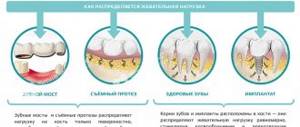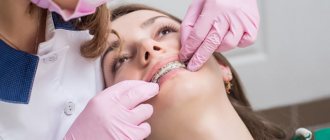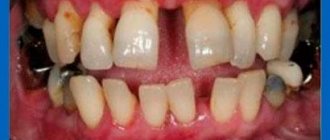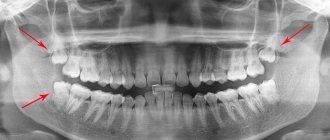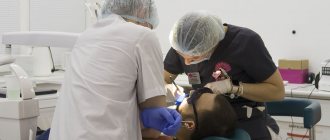Severe periodontitis
At this stage, the treatment of periodontitis is no longer limited to conservative measures; here it is necessary to resort to surgical methods of treatment - removal of the most damaged teeth, open curettage, and flap operations.
In addition, in case of severe periodontitis, targeted regeneration (building) of bone tissue is used with the help of osteogenic preparations, membranes, etc., which strengthen and compact the bone and create the prerequisites for its restoration where possible.
Closed curettage of periodontal pockets
Closed curettage or curettage is one of the few methods of treating periodontitis that allows you to eliminate granulations and various types of dental plaque from periodontal pockets. However, due to the lack of visual control, the doctor is not always able to completely eliminate these problems, which reduces the effectiveness of this method. That is why it is used for shallow periodontal pockets, which is typical for the earliest stages of the disease. With a more extensive lesion, the technique can only temporarily improve the patient’s health, but sooner or later periodontitis will begin to recur, which will require re-treatment.
Among the advantages of this type of surgical treatment are:
- Good aesthetic result.
- Rapid gum recovery.
- Minor blood loss.
Due to the features described above, closed curettage is not always used.
Where to treat gum diseases in Moscow?
Many patients who suffer from periodontal disease often ask the same question: how to treat periodontal disease? When you start talking to them and hear this question, you ask, why don’t you ask how to treat periodontitis?
Unfortunately, not all people know what periodontitis is, they do not understand what causes periodontal disease, they have no idea what symptoms accompany these two diseases, how to prevent the risk of their occurrence and how modern treatment of dental gums is carried out. Therefore, before looking for an answer to the question of how to treat periodontal disease, it is advisable to find out what specific periodontal tissue disease you have.
If you want to understand in detail the theoretical aspects of your gum disease, then you can, first, place a query in an Internet search engine: periodontitis symptoms and treatment. Then you can compare the symptoms that you have and the symptoms of periodontitis. It will be possible to roughly understand what kind of gum disease we are talking about in your particular case. Also, since the request “periodontitis symptoms and treatment” includes a request for treatment of gums, you will be provided with a significant list of clinics whose specialists provide treatment for periodontitis.
In this article we will tell you in detail about what periodontal disease and periodontitis are, how these diseases differ from each other, as well as the main diagnostic methods and technologies that allow for optimal treatment of gums (periodontitis).
[]
The doctors of our clinic are dental therapists:
Inessa Khautievna Fitsezh
Dentist-therapist, orthopedist
Clinical experience over 15 years
Kawas Naji
Orthopedic dentist, therapist
Clinical experience over 29 years
All doctors of our clinics »
Open curettage of periodontal pockets
This type of operation does not have the disadvantages of the previous method. A good overview of the problem area allows the doctor to remove all granulation tissue and thereby prevent further progression of the disease. Open curettage is performed under local anesthesia and takes place in several stages:
- The surgeon makes an incision in the gum in the projection of the neck of the tooth.
- A certain area of the mucous membrane peels off.
- Granulations and deposits in periodontal pockets are eliminated.
- If necessary, plastic surgery of bone defects is performed.
- The flap is sutured, the surgical field is treated and protected with an aseptic dressing.
Due to the high traumatic nature of soft tissues, a limited area of gum can be treated in one operation, usually up to 8 teeth. After the wound has healed, repeated interventions are performed.
Decayed tooth
The most common indication for surgical extraction of a tooth is its complete destruction. Such situations are not uncommon, and our lifestyle is to blame, as well as ignoring the need for timely treatment. Usually, in such conditions, a specialist prescribes radiography. If it demonstrates that the tooth is indeed completely destroyed, and all that remains is the root with inflamed soft tissue around it, almost every dentist will decide to refer you to a surgeon to perform tooth extraction surgery. However, there remains a chance for salvation. There is a treatment method called depophoresis, which combines elements of electrophoresis and drug therapy. Depophoresis is performed as follows:
- Under the influence of weak pulses of electric current, a medicinal preparation, which is a concentrate of copper ions, is supplied to the roots of the tooth;
- Copper, which has powerful bactericidal properties, penetrates into thin canals and fills them, simultaneously killing all pathogenic flora that parasitize the tooth;
- The medicine settles in the canals for a long time, creating a reliable depot for infection for several years to come.
Since the tooth root becomes sterile after such a procedure, it can serve as a full-fledged support for the installation of prostheses and microprostheses (crowns). A similar treatment method is sometimes used for pulpitis, especially if the patient has hard-to-reach, branched or deformed roots. It is used in the treatment of canal obstruction, when the dentist’s instruments cannot penetrate into the desired place and deliver medications to the internal structures of the tooth.
Why is curettage needed?
The process of development of periodontitis is slow and occurs in a certain sequence. First, due to poor oral hygiene, the active proliferation of microorganisms begins, which in the process of their vital activity release a large number of toxins. These toxins have a negative effect on the gums and cause inflammation.
If the patient does not seek medical help at this stage, the inflammation gradually leads to the detachment of the gum from the tooth and the formation of periodontal pockets. These pockets contain food debris and soft dental deposits, which over time mineralize and become hard. Ideal conditions are created for the proliferation of microorganisms that affect not only the gums, but also the bone structures. As a result, granulation tissue is formed, which contributes to the rapid destruction of bone and loosening of teeth. If it is not completely removed, periodontitis will progress further, leading to more severe consequences. In order to effectively clean periodontal pockets from dental plaque, hard deposits and granulations, curettage is used.
Types of Tartar
Before you treat dental deposits, you need to understand what they are. The deposit can be soft or hard, with the former transitioning into the latter. Naturally, it is easier to treat the first option. Also, depending on the location, supragingival and subgingival deposits are distinguished. The first ones are easily identified, since they are not hidden by the gum. Identifying the latter is difficult, since they are covered by the gums.
When soft plaque accumulates and has not been removed for a long time, it hardens and thickens, resulting in the appearance of deposits on the teeth. These deposits can only be removed in a dental office using a special technique.
Flap surgery for periodontitis
Flap surgery is indicated for patients with pronounced periodontal changes: pocket depths of more than 5 mm, active inflammation, etc. This technique allows not only to eliminate various types of deposits and granulations, but also to restore interdental defects and bone tissue defects. To form a flap, precise cuts are made in a specific direction:
- Horizontal cuts are always made. They can run either inside the gingival sulcus or parallel to the gum edge.
- Vertical incisions allow you to expand the surgical field, but lead to the formation of scar changes in the gums, so they are performed only when necessary.
Among the disadvantages of flap surgery, there is a possibility of flap displacement and exposure of the neck of the tooth. This complication worsens the aesthetics of the oral cavity, contributes to increased tooth sensitivity and the development of tooth root caries.
Bone grafting
In severe periodontitis, there is a loss of bone tissue, which contributes to the loosening of teeth. In order to stop this process, bone grafting is used. The patient's own tissue, as well as artificial substitutes, can be used as a graft. In the first case, a section of bone can be taken from the chin, upper palate, or lower jaw. Since the patient’s own tissues are absolutely biocompatible, this method is the most effective, but requires two operations: tissue collection and transplantation.
Special bone substitutes do not have this disadvantage, so bone grafting in such cases is carried out in one stage. However, this method is characterized by a lower tissue survival rate, so it is not always possible to achieve the desired result with its help.
Periodontitis
Periodontitis is an inflammatory process in the periodontium, which is characterized by destruction of the tissues of the ligamentous apparatus that fixes the tooth in the alveolus. It almost always results in the formation of a granuloma with pathological exudate (pus) in the root canal. It is noteworthy that many dentists almost always make a verdict that removal is necessary. However, in reality the situation is different. Firstly, the direct indication for removal for periodontitis is the absolute failure of primary conservative treatment. If you were not offered it at all, it makes sense to go to another clinic. Secondly, extraction is usually indicated on multi-canal teeth if traditional therapy for the disease has not brought results. Strictly speaking, the front teeth (incisors and canines) with this pathology and the proper approach to its treatment can almost always be preserved. If, when diagnosed with periodontitis, you are offered to remove a tooth, do not rush to do it, especially if you yourself do not see the objective problem. Visit a consultation with another specialist, or better yet, several, to come to clear and correct conclusions.
Plastic surgery of lip cords and frenulums
In the presence of pronounced strands of the mucous membrane, the risk of periodontal disease increases significantly. Massive folds that are fixed to the gingival papillae, when stretched, can displace them and lead to various problems. In order to prevent such conditions, band plasty is performed. Typically, the technique consists of excision of these folds and subsequent suturing of the resulting defect.
Lip frenuloplasty can be performed in the following cases:
- Pronounced tooth gap between the front incisors.
- Preparation for orthodontic treatment.
- Presence of gum recession.
- Before installing removable dentures.
- Incorrect sound pronunciation.
Surgical treatment can be performed in various ways. If the frenulum is very narrow, then it is cut transversely. If there is a wide frenulum, its excision is performed. In addition, individual sections can be moved to the desired position.
Among modern techniques, laser frenuloplasty is noted. The procedure is very quick, does not require stitches, has a short recovery period and rarely leads to complications.
After plastic surgery of the cords and labial frenulum, a period of rehabilitation begins. Typically, the patient is required to follow simple rules, which include careful oral hygiene and a certain diet. Typically, recovery takes about a week.
Closing gum recessions
Closing gum recessions is carried out only by surgical methods, which involve moving donor flaps to the recession zone and plastic surgery of the existing defect. You can receive a transplant in several ways:
- Pedicled flap. In this case, the donor tissue is a nearby area of the mucous membrane. The technique is used in the presence of localized defects.
- Gingival flap. It is taken from the gum area, provided that the volume of tissue in the selected area is sufficient.
- A scrap from the sky. In this case, the donor fragment is taken from a specific area of the hard palate
To close recession zones, the method of directed tissue regeneration can be used. In this case, special membranes are used as donor tissue, which can be absorbable or non-absorbable. These membranes promote the migration of cells from natural tissues and subsequent regeneration of the damaged area.
This method does not require the formation of a donor wound, but is not suitable for all patients. To obtain a successful result, the membrane must be covered with a layer of mucous membrane, which will provide the necessary nutrition, which is not always possible. In addition, due to the long process of formation of new tissue, it is necessary to observe certain rules of oral hygiene, therefore this method requires the active and conscientious participation of the patient in the treatment process.
Transplantation of a flap from the palate
Recession flaps are usually taken from the hard palate. In this case, the graft can consist only of connective tissue, or be epithelialized. The thickness of the flap depends on the tasks and the result that needs to be achieved. Direct closure of gingival recessions requires thick flaps, while restoration of visible gingival areas is carried out using thin and epithelialized fragments.
The graft is usually taken from the area of the hard palate, which borders the canines and premolars. In this case, it is necessary to retreat 2 mm from the edge of the gum. These rules allow you to avoid crossing the palatine artery and the development of bleeding. The thickness of the mucous membrane from the donor area should not be less than three millimeters, so probing is carried out first. After obtaining a flap, the defect is sutured
